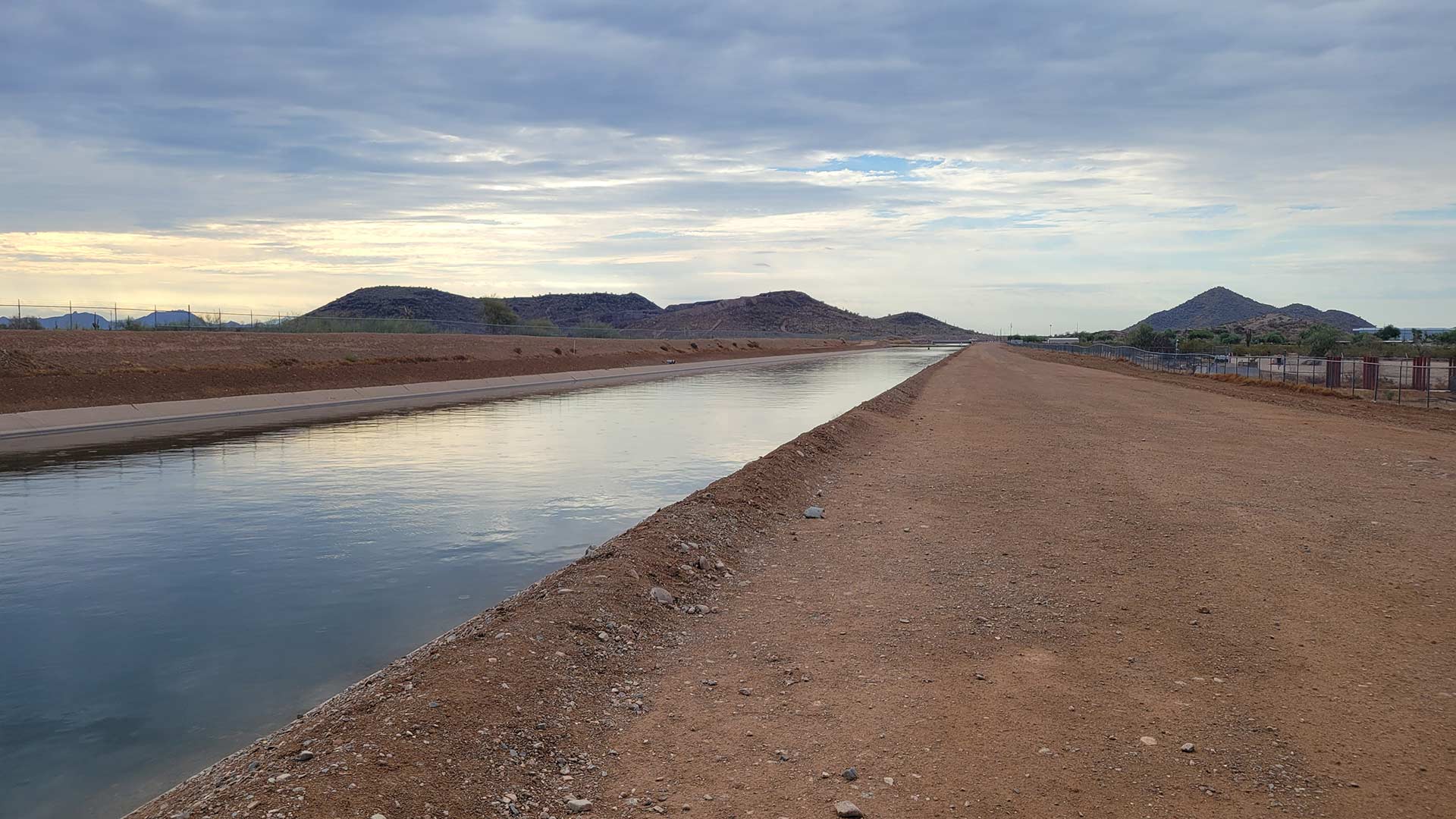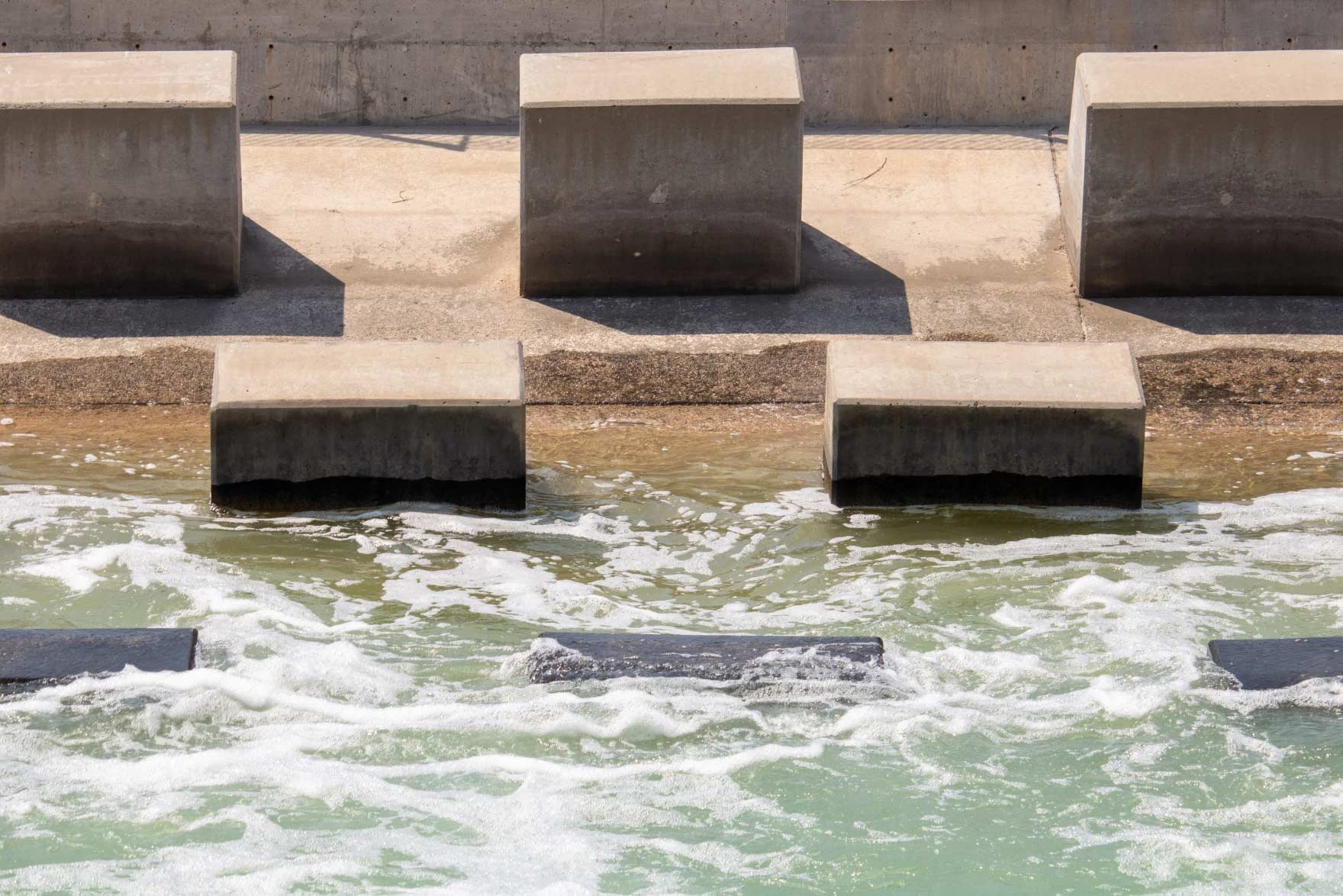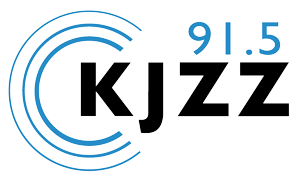 The Central Arizona Project canal just north of CAP headquarters near Phoenix.
The Central Arizona Project canal just north of CAP headquarters near Phoenix.
The Central Arizona Project.
It sounds more like a band name than the name of a critical 336-mile-long aqueduct that shuttles Colorado River water through the state. While you may have heard of CAP, you may not be exactly sure how it all works.
KJZZ recently took a behind-the-scenes tour of the system that keeps the flow going for millions of Arizonans.
CAP crews were planning a “blow off." That’s what engineers call it when millions of gallons of water is discharged from a 1-mile-long siphon in northwest Phoenix. It only happens about once per decade.
 VIEW LARGER The CAP system has ten siphons, all with similar basic anatomy. The siphons are massive pipelines.
VIEW LARGER The CAP system has ten siphons, all with similar basic anatomy. The siphons are massive pipelines. “We’re at the Aqua Fria siphon and what CAP is doing essentially is we’re gearing up for prescribed maintenance to keep this siphon in operation, which is a critical part of the infrastructure that delivers water from Lake Havasu to Tucson," said Jason Terrell, CAP’s senior project manager.
And what happens if it doesn’t go as planned?
“There’s gonna be a lot of angry folks out there, I’ll tell you what,” Terrell said laughing. He admits not many people know what CAP does.
"Absolutely not. It’s funny. I think a lot of questions come up for me and I’m sure other folks at CAP when we go out and meet up with friends and we’re at our barbeques or just meeting with family and then the questions start, so yeah even my wife will ask me questions about what exactly we’re doing out here,” Terrell said.
The dewatering process is necessary for CAP inspectors to get inside the mile-long siphon, 9 feet in diameter, that mostly runs underground south of Lake Pleasant.
It’s extraordinary maintenance. The last time they got inside this massive metal tube was 2018 for an inspection, but the last time they’ve done actual work on it was 15 years ago.
They’re preparing for what amounts to a "canal colonoscopy," according to CAP field maintenance Director Rich Weissinger.
“Part of our maintenance philosophy is to periodically get inside some of our equipment, our infrastructure and this is one of the things that we don’t get to do too often, is dry up one of these siphons to get in there and inspect,” Weissinger said.
He knows most people don’t get what CAP actually does.
“CAP itself is difficult to understand. I don’t think a lot of people know, it’s kind of a ... we call it the best kept secret in the Valley. But it’s very important to the state ensuring that we get Colorado River water to central and southern Arizona," Weissinger said.
 VIEW LARGER Part of the Central Arizona Project aqueduct near the Agua Fria siphon in northwest Phoenix in July 2025.
VIEW LARGER Part of the Central Arizona Project aqueduct near the Agua Fria siphon in northwest Phoenix in July 2025. CAP was created in 1968 when President Lyndon Johnson signed the Colorado River Basin Act.
Today, it typically has more than 60 users, including the Phoenix, Scottsdale, Mesa, Glendale, Peoria and Tucson — along with 11 tribal nations. It also supplies several agricultural interests along the route.
Weissinger has been at the CAP for nearly half of its existence. When the Arizona native first started here, our current megadrought hadn’t even begun.
“We’ve had a kind of a dry spell for quite a few years. I’ve been here 27 years, so I’ve seen the kind of the ebbs and flows in a cycle a little bit," Weissinger said.
But he says the sense of urgency has changed.
“We’re in a time that’s pretty concerning. We’ve got a lot of work to do to ensure that this next negotiation, or 2026 agreement, getting that re-done is really imperative to Arizona and the ability to use this infrastructure to move water," Weissinger said.
Weissinger is referring to more uncertainty facing the system as discussions continue on future allocations for the seven states and Mexico that share the dwindling supply of Colorado River water.
“We didn’t really think about where water was coming from, so it has been concerning. It’s nice to be able to communicate that to that to our field folks, to ensure that they feel confident that this infrastructure will be here for years to come. So that’s changed in our mindset of just how important this is,” Weissinger said.
With supplies dwindling, current rules for users of the Colorado River basin expire at the end of next year for the system that right now at least carries 1.4 million acre feet of water throughout the state yearly to nearly 6 million Arizona users.


By submitting your comments, you hereby give AZPM the right to post your comments and potentially use them in any other form of media operated by this institution.